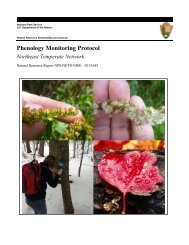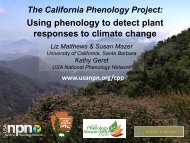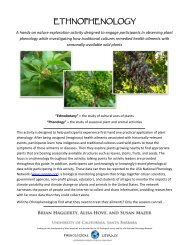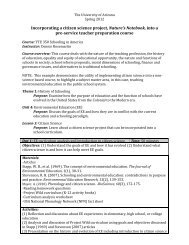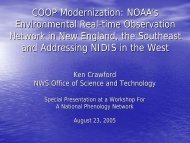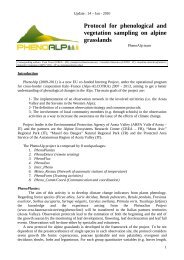Plant Phenophase Datasheet
Plant Phenophase Datasheet
Plant Phenophase Datasheet
You also want an ePaper? Increase the reach of your titles
YUMPU automatically turns print PDFs into web optimized ePapers that Google loves.
Forbs<br />
Species: Rorippa nasturtium-aquaticum<br />
Common Name: watercress<br />
Directions: Fill in the date and time in the top rows and circle the appropriate letter in the column below.<br />
Nickname:<br />
y (phenophase is occurring); n (phenophase is not occurring); (not certain if the phenophase is occurring).<br />
Site:<br />
Do not circle anything if you did not check for the phenophase. In the adjacent blank, write in the appropriate measure of intensity or abundance for this phenophase. Year:<br />
Observer:<br />
Date:<br />
Date:<br />
Date:<br />
Date:<br />
Date:<br />
Date:<br />
Date:<br />
Date:<br />
Do you see...<br />
Time:<br />
Time:<br />
Time:<br />
Time:<br />
Time:<br />
Time:<br />
Time:<br />
Time:<br />
Initial growth<br />
Leaves<br />
Flowers or flower buds<br />
Open flowers<br />
Fruits<br />
Ripe fruits<br />
Recent fruit or seed drop<br />
Check when data entered online:<br />
Comments:<br />
Date:<br />
Date:<br />
Date:<br />
Date:<br />
Date:<br />
Date:<br />
Date:<br />
Date:<br />
Do you see...<br />
Time:<br />
Time:<br />
Time:<br />
Time:<br />
Time:<br />
Time:<br />
Time:<br />
Time:<br />
Initial growth<br />
Leaves<br />
Flowers or flower buds<br />
Open flowers<br />
Fruits<br />
Ripe fruits<br />
Recent fruit or seed drop<br />
Check when data entered online:<br />
Comments:<br />
<strong>Plant</strong> <strong>Phenophase</strong> <strong>Datasheet</strong><br />
Contact: nco@usanpn.org | More information: www.usanpn.org/how-observe<br />
PAPERWORK REDUCTION ACT STATEMENT: In accordance with the Paperwork Reduction Act (44 U.S.C. 3501), please note the following. This information collection is authorized by Organic Act, 43 U.S.C. 31 et seq., 1879 and Fish and Wildlife Coordination Act. Your response is voluntary. We estimate that it will take approximately 2 minutes to make and report observations per respondent.<br />
An agency may not conduct or sponsor and a person is not required to respond to a collection of information unless it displays a currently valid Office of Management and Budget control number. OMB has reviewed and approved this information collection and assigned OMB Control Number 1028-0103. You may submit comments on any aspect of this information collection, including<br />
the accuracy of the estimated burden hours and suggestions to reduce this burden. Send your comments to: Information Collection Clearance Officer, U.S. Geological Survey, 12201 Sunrise Valley Drive, MS 807, Reston, VA 20192. OMB Control #: 1028-0103 Expiration Date: 01/31/2016
Watercress<br />
(Rorippa nasturtium-aquaticum)<br />
<strong>Phenophase</strong> Definitions<br />
Directions:<br />
As you report on phenophase status (Y, N or ) on the datasheets,<br />
refer to the definitions on this sheet to find out what you should<br />
look for, for each phenophase in each species. To report<br />
the intensity of the phenophase, choose the best answer to the question below<br />
the phenophase, if one is included. Feel free not to report on phenophases or intensity questions<br />
that seem too difficult or time-consuming.<br />
Leaves<br />
Initial growth<br />
New growth of the plant is visible after a period of no growth (winter or drought), either from aboveground<br />
buds with green tips, or new green or white shoots breaking through the soil surface. Growth is<br />
considered "initial" on each bud or shoot until the first leaf has fully unfolded. For seedlings, "initial"<br />
growth includes the presence of the one or two small, round or elongated leaves (cotyledons) before the<br />
first true leaf has unfolded.<br />
Leaves<br />
One or more live, fully unfolded leaves are visible on the plant. For seedlings, consider only true leaves<br />
and do not count the one or two small, round or elongated leaves (cotyledons) that are found on the<br />
stem almost immediately after the seedling germinates. Do not include fully dried or dead leaves.<br />
Flowers<br />
Flowers or flower buds<br />
One or more fresh open or unopened flowers or flower buds are visible on the plant. Include flower buds<br />
that are still developing, but do not include wilted or dried flowers.<br />
How many flowers and flower buds are present For species in which individual flowers are clustered in flower heads,<br />
spikes or catkins (inflorescences), simply estimate the number of flower heads, spikes or catkins and not the number<br />
of individual flowers.<br />
Less than 3; 3 to 10; 11 to 100; 101 to 1,000; More than 1,000;<br />
Open flowers<br />
One or more open, fresh flowers are visible on the plant. Flowers are considered "open" when the<br />
reproductive parts (male stamens or female pistils) are visible between or within unfolded or open flower<br />
parts (petals, floral tubes or sepals). Do not include wilted or dried flowers.<br />
What percentage of all fresh flowers (buds plus unopened plus open) on the plant are open For species in which<br />
individual flowers are clustered in flower heads, spikes or catkins (inflorescences), estimate the percentage of all<br />
individual flowers that are open.<br />
Contact: nco@ usanpn.org | M ore inform ation: w w w.usanpn.org/how -observe
Less than 5%; 5-24%; 25-49%; 50-74%; 75-94%; 95% or more;<br />
Fruits<br />
Fruits<br />
One or more fruits are visible on the plant. For Rorippa nasturtium-aquaticum, the fruit is a slender<br />
capsule that changes from green to tan or brown and splits open to expose the seeds. Do not include<br />
empty capsules that have already dropped all of their seeds.<br />
How many fruits are present<br />
Less than 3; 3 to 10; 11 to 100; 101 to 1,000; More than 1,000;<br />
Ripe fruits<br />
One or more ripe fruits are visible on the plant. For Rorippa nasturtium-aquaticum, a fruit is considered<br />
ripe when it has turned tan or brown and has split open to expose the seeds. Do not include empty<br />
capsules that have already dropped all of their seeds.<br />
What percentage of all fruits (unripe plus ripe) on the plant are ripe<br />
Less than 5%; 5-24%; 25-49%; 50-74%; 75-94%; 95% or more;<br />
Recent fruit or seed drop<br />
One or more mature fruits or seeds have dropped or been removed from the plant since your last visit.<br />
Do not include obviously immature fruits that have dropped before ripening, such as in a heavy rain or<br />
wind, or empty fruits that had long ago dropped all of their seeds but remained on the plant.<br />
How many mature fruits have dropped seeds or have completely dropped or been removed from the plant since your<br />
last visit<br />
Less than 3; 3 to 10; 11 to 100; 101 to 1,000; More than 1,000;<br />
Contact: nco@ usanpn.org | M ore inform ation: w w w.usanpn.org/how -observe



